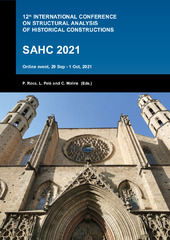Приказ основних података о документу
Design of Protective Structures for Active Archeological Sites
| dc.creator | Petrović, Milica | |
| dc.creator | Ilić, Isidora D. | |
| dc.creator | Džombić, Neda M. | |
| dc.creator | Šekularac, Nenad D. | |
| dc.date.accessioned | 2023-11-28T19:16:40Z | |
| dc.date.available | 2023-11-28T19:16:40Z | |
| dc.date.issued | 2021 | |
| dc.identifier.isbn | 978-84-123222-0-0 | |
| dc.identifier.issn | 2696-9157 | |
| dc.identifier.uri | https://raf.arh.bg.ac.rs/handle/123456789/1726 | |
| dc.description.abstract | This paper presents a structural design methodology in order to find the best possible solution of protective structures for active archeological sites. Besides the typical demands for construction on these sites which arise from the typology and the level of protection of cultural heritage, active archeological sites require a structural solution with regard to time and direction of further excavation. The hypothesis is that modular spatial structures which are easily assembled or disassembled, and have the ability to be extended in one or more directions, are the most functional solution for these sites. This paper shows the analysis of several types of spatial structures based on the requirements of active archeological sites. It explores the possibilities of structural systems derived from multiplication of one primary element of structure, their material and joints between elements. The most adequate assembly of the entire structure is supposed to be found in the interdependency of the load and the dimension of the element’s cross- section, in a suitable geometric configuration. The focus of the analysis is on structures made of short-bearing elements which have the advantage of the efficiency of transport and assembling. One of the design criteria for this methodology is that the structural system itself looks simple and elegant in order to complement the archeological site. This is shown in the paper through the analysis of patterns in which these structures are assembled. The aim is to correlate the position of the elements in the structural system, the dimensions of cross-section, and the lengths of the straight beams which form the spatial structure in order to find a simple, functional and economical solution for protective structures at active archeological sites. The conclusion shows the advantages and disadvantages of the design methodology presented in the paper, as well as the discussion about the analyzed spatial structures. This type of methodology that systematizes various design criteria from different fields of research engages the problem of design of protective structures for archeological sites and opens up new questions for further research. | sr |
| dc.language.iso | en | sr |
| dc.publisher | SAHC | sr |
| dc.rights | openAccess | sr |
| dc.rights.uri | https://creativecommons.org/licenses/by-nc-sa/4.0/ | |
| dc.source | 12th International Conference on Structural Analysis of Historical Constructions (SAHC) | sr |
| dc.subject | structural analysis | sr |
| dc.subject | design methodology | sr |
| dc.subject | protective structures | sr |
| dc.subject | single layer structures | sr |
| dc.title | Design of Protective Structures for Active Archeological Sites | sr |
| dc.type | conferenceObject | sr |
| dc.rights.license | BY-NC-SA | sr |
| dcterms.abstract | Джомбић, Неда; Шекуларац, Ненад; Илић, Исидора; Петровић, Милица; Десигн оф Протецтиве Струцтурес фор Aцтиве Aрцхеологицал Ситес; Десигн оф Протецтиве Струцтурес фор Aцтиве Aрцхеологицал Ситес; | |
| dc.identifier.doi | 10.23967/sahc.2021.074 | |
| dc.identifier.fulltext | http://raf.arh.bg.ac.rs/bitstream/id/6049/bitstream_6049.pdf | |
| dc.type.version | publishedVersion | sr |

